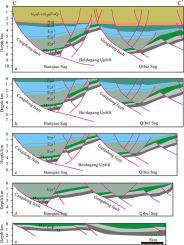Journal of Asian Earth Sciences ( IF 3 ) Pub Date : 2021-07-24 , DOI: 10.1016/j.jseaes.2021.104898 Nan Jia 1, 2 , Chiyang Liu 2 , Lei Huang 2 , Lihong Zhou 3 , Shaohua Zhang 4 , Di Li 5

|
The formation of uplifts in rift basins is generally controlled by fault-block tilting and/or regional uplift. The Beidagang Uplift, located in the middle part of the Qikou Sag of the Bohai Bay Basin, is an important hydrocarbon accumulation zone that has experienced a complex evolutionary history since the Cenozoic. In this study, we conducted apatite fission track (AFT) analysis and structural analysis of seismic data to distinguish the processes of fault-block tilting and regional uplift, and unravel the uplifting history and formation mechanism of the Beidagang Uplift. The results show that the Beidagang Uplift experienced two stages of tectonic uplift and exhumation mainly in the early Cenozoic (65–45 Ma) and a late depositional stage of early Eocene to the early Miocene (40–18 Ma). The uplift and exhumation substages of 40–38 Ma, 26–24 Ma and 24–18 Ma were caused by regional uplift, whereas those of 38–32 Ma and 32–26 Ma were mainly due to fault-block tilting. These rapid tectonic uplift and exhumation events recorded by the AFT data were closely related to the regional dynamic background as evidenced by a wide range of responses in eastern China. This study provides a good case for distinguishing between the effects of tilting and regional uplift in the formation of uplifts within rift basins, and has profound implications for regional dynamics.



























 京公网安备 11010802027423号
京公网安备 11010802027423号